Artillery at Clevedon
On the 22 November 1859, the Gloucestershire Volunteer Artillery (GVA) was formed, making it's headquarters at the Artillery Ground, Whiteladies Rd. Clifton, Bristol. The unit started with five batteries with a sixth added later. The GVA were tasked with the defence of the Bristol Channel and the ports of Bristol and Gloucester and were fully paid for and organised by the City of Bristol, it was not part of the War Office responsibilities.
From October 1871 until July 1874, except for a short spell on Dartmoor in late July and early August 1873, 'K' Battery, 4 Brigade, Royal Artillery were at Horfield Barracks, Bristol, and in July of both 1872 and 1873 they availed themselves of the facilities at Portishead. In 1881 the 1st Gloucestershire Artillery Volunteers moved their range from Portishead to Clevedon to have the benefits of a land range, but the practice battery at old battery remained intact until 1899 when the buildings at Portishead were finally demolished and the 64 pounder rifled, muzzle loading (RML) guns by then installed returned to stores.
In March 1880, the Gloucestershire Volunteer Artillery had become the 1st Gloucestershire Artillery Volunteers (Gloucester and Somerset).
Starting in 1906, the Secretary of State for War Richard Haldane's Reforms were designed to better prepare the armed forces for future wars and involved a reorganization of the regular, volunteer and militia forces. The Territorial and Reserve Forces Act of 1907 saw the formation of the Territorial Force which consisted of fourteen infantry divisions, fourteen cavalry brigades, and a large number of support units including fully established divisions, provided with field artillery, companies of engineers and crucial supply services, including medical provision. The GVA became part of the Territorial Force, an army tasked with the defence of the UK, and came under the control of the War Office.
Under Haldene's Reforms, the units became the 2nd South Midland (Gloucestershire) Brigade, Royal Field Artillery (RFA), but this was changed in 1910 to 1st South Midland (Gloucestershire) Brigade, RFA. It formed part of the South Midland Division of the TF, with the following organisation (each battery consisted of four 15-pounder guns):
HQ: Artillery Grounds, Clifton
1st Gloucestershire Battery, Artillery Grounds, Clifton
2nd Gloucestershire Battery, Artillery Grounds, Clifton
3rd Gloucestershire Battery, Barracks, Gloucester
1st South Midland Ammunition Column, Clifton
1st Gloucester RGA Volunteers were mostly based in Bristol. Battery Nos. 1, 2, 3, 4, 5, and 6, were based at Bristol; No. 7 at Newham-on-Severn; No. 8 at Gloucester; No. 9 at Clevedon; No. 10 at Portishead; and No. 11 at Weston-Super-Mare.
Artillerymen
On the 22 November 1859, the Gloucestershire Volunteer Artillery (GVA) was formed, making it's headquarters at the Artillery Ground, Whiteladies Rd. Clifton, Bristol. The unit started with five batteries with a sixth added later. The GVA were tasked with the defence of the Bristol Channel and the ports of Bristol and Gloucester and were fully paid for and organised by the City of Bristol, it was not part of the War Office responsibilities.
The Clevedon Artillery Volunteers (initially known as the 1st Somerset Artillery Corps) were formally adopted into the 1st Artillery Volunteer Corps (Portishead and Clevedon) on 18 June 1860. In November 1863, the 1st (Clevedon) Somerset Artillery Corps, the No.2 (Newham) and No3 Gloucestershire Artillery Corps was formed with the Bristol Corps into an Administrative Brigade and was designated 1st. Administrative Brigade and Gloucestershire Artillery Volunteers. Major Savile appointed to the command of the Brigade with the rank of Lieut. Col. Lord Glentworth, late of the Rifle Brigade, appointed Major of the Brigade.
In March 1880, the Gloucestershire Volunteer Artillery had become the 1st Gloucestershire Artillery Volunteers (Gloucester and Somerset) with 720 all ranks. At its inception, the battery at Clevedon mustered nearly 45 men and almost a year later The Weston-super-Mare Gazette was reporting a roll of over 50. The unit was commanded by various members of the Elton and Trestrail families up until the point of its disbandment in 1908 under the Haldene Reforms.
Not much is known about the artillerymen at Clevedon. This list is far from complete but was compiled by Derek Driscoll from the scrapbook of No 4 Company, Sgt Major H. J. Warren R.G.A. (V), the Regiment orders that were printed in local newspapers such as the Bristol Observer, Western Daily Press and Bristol Times & Mirror.
A Clevedon street directory lists the chief officers as:
Sir E. H. Elton bart. Captain;
A. B. Trestrail, Lieutenant
Stephen Skinner, Acting Surgeon
William Thomas Moore, B.S.M. & drill instructor
Sir Arthur Hallam Elton, Bart., William Jerdone Braikenridge, and Sir Edmund Harry Elton, Bart., in turn commanded the Clevedon Company or were officers of the Company. Major Alfred Bond Trestrail, V.D., commanded the Company from 1890 to 1905, when be retired.
The following list of No 9 Battery is taken from 1st Gloucester RGA Volunteers Nominal Roll of 1898.Binding - Quartermaster Sgt (QMS)
Blackmore, Sergeant
Kitchen, Corporal
O'Brian, Gunner
Purnell, C. W., Sergeant
Spencer, T. - Captain, Officer commanding No. 9 battery
Taylor, J. W., Corporal
Trestrail, Alfred Ernest Yates, Lieutenant
The Walking the Battlefields site has a great picture of Clevedon's No. 9 Battery taken in May 1888.
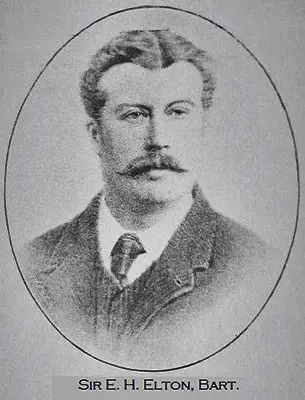 Elton -Sir Edmund Harry Elton, Bart., C.C., Major and Hon-Lieutenant-Colonel 1st Gloucestershire Volunteer Artillery, Clevedon Court, Clevedon, Somerset [8th Baronet] Son of the late Edmund William Elton, Esq., Born at Clifton, May 3rd, 1846; educated at Bradford College, Berks, and Jesus College, Cambridge; rowed in the Jesus College boat, 1865; won the "Larking" Challenge Sculls,1864; High Sheriff for Somerset, 1895; originator and designer of the "Elton Ware" pottery, which has been awarded nine gold and two silver medals, mostly at international exhibitions.
Elton -Sir Edmund Harry Elton, Bart., C.C., Major and Hon-Lieutenant-Colonel 1st Gloucestershire Volunteer Artillery, Clevedon Court, Clevedon, Somerset [8th Baronet] Son of the late Edmund William Elton, Esq., Born at Clifton, May 3rd, 1846; educated at Bradford College, Berks, and Jesus College, Cambridge; rowed in the Jesus College boat, 1865; won the "Larking" Challenge Sculls,1864; High Sheriff for Somerset, 1895; originator and designer of the "Elton Ware" pottery, which has been awarded nine gold and two silver medals, mostly at international exhibitions.
Major and Honorary Lieutenant-Colonel Sir Edmund Harry Elton, Bart., of Clevedon Court, Somerset resigned his Commission, with permission to retain his rank and to wear the uniform of the corps on retirement. Dated 28th May, 1902.
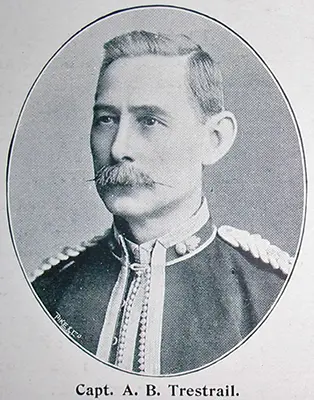 Trestrail - Alfred Bond Trestrail F.R.G.S., Captain, Gloucestershire Volunteer Artillery, of Southdale, Clevedon, Somerset. Born Surry, Febuary 5th, 1849; educated at Mill Hill School, Amersham Hall School, the Royal College of chemistry and the Royal School of Mines. Gazetted to the Gloucestershire Volunteer Artillery, 1885; Captain of No 9 Company since 1891. This Company was originally called the "Clevedon" or 1st Somerset Gloucestershire Volunteer Artillery Volunteer Corps, and was command by Sir Arthur Hallam Elton, Bart., and afterwards by Sir Edmund Harry Elton. Formed in 1860, it became part of of the 1st Gloucestershire Volunteer Artillery in 1880. in 1886 it stood second in the Brigade for skill-at-arms, the competition being held at Portishead Battery , for some years the Sergeants and Corporals have held the 3rd and 4th Cups for carbine shooting at the annual brigade competitions.
Trestrail - Alfred Bond Trestrail F.R.G.S., Captain, Gloucestershire Volunteer Artillery, of Southdale, Clevedon, Somerset. Born Surry, Febuary 5th, 1849; educated at Mill Hill School, Amersham Hall School, the Royal College of chemistry and the Royal School of Mines. Gazetted to the Gloucestershire Volunteer Artillery, 1885; Captain of No 9 Company since 1891. This Company was originally called the "Clevedon" or 1st Somerset Gloucestershire Volunteer Artillery Volunteer Corps, and was command by Sir Arthur Hallam Elton, Bart., and afterwards by Sir Edmund Harry Elton. Formed in 1860, it became part of of the 1st Gloucestershire Volunteer Artillery in 1880. in 1886 it stood second in the Brigade for skill-at-arms, the competition being held at Portishead Battery , for some years the Sergeants and Corporals have held the 3rd and 4th Cups for carbine shooting at the annual brigade competitions.
Alfred Bond Trestrail was born at the 'Willows', Mitcham Common, Surrey in February 1849. He was the second son of the Reverend Frederick Trestrail, and was educated at Mill Hill and Amersham Hall Schools. Trestrail later attended the Royal College of Chemistry and the Royal School of Mines.
Trestrail resided at 'Southdale', Albert Road, Clevedon, and was commissioned Lieutenant in the 1st Gloucestershire Royal Garrison Artillery Volunteers (Clevedon Company), in March 1885. He advanced to Captain and took over command of No. 9 Battery in November 1891.
Trestrail retired as Honorary Major in September 1905. He 'took a prominent interest in municipal affairs. For over 20 years he was a member of the Urban District Council. He was made a JP in 1896, and sat regularly on the local Bench (frequently as presiding magistrate) until his illness. He was prominently identified with many local charitable and philanthropic institutions, notably the Clevedon, Kenn, Tickehham and Walton Dispensary, of which he had been Hon. Secretary and Treasurer for many years.... He also took a great interest in sport. He was a member of the Somerset County Football Association and served on the board of Appeal. He was a vice president of the local football and cricket clubs, a founder of the original golf club, a founder and vice president of the bowling club, and trustee of the Herbert Gardens. A keen Volunteer, he succeeded the late Sir Edmund H. Elton, Bart., as Captain of the Clevedon Company, Royal Gloucestershire Artillery Volunteers, and put in over 20 years service. During the Great War, he commanded the local Red Cross Hospital, and was awarded the MBE for his services.' (Obituary taken from the Bristol Times & Mirror).
Major Trestrail died in April 1925, and is buried in Clevedon Cemetery.
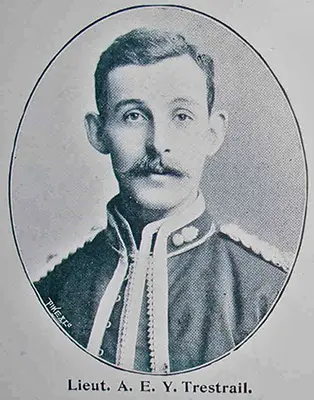 Trestrail - Alfred Ernest Yates Trestrail, B.A., First Lieutenant, Gloucestershire Volunteer Artillery, of Southdale Clevedon, Somerset. born January, 24th 1876 at Hallatrow Court, Hallatrow, Somerset; educated at Amersham Hall School, New College, Eastbourne, and Christ's College, Cambridge, Graduated B.A.; has studied for the law. Has also played football for Clevedon since 1890, Somerset County association since 1894, also played for Cambridge university; Crusaders F. C. and Bedminster F. C. Was Gazetted January 1896.
Trestrail - Alfred Ernest Yates Trestrail, B.A., First Lieutenant, Gloucestershire Volunteer Artillery, of Southdale Clevedon, Somerset. born January, 24th 1876 at Hallatrow Court, Hallatrow, Somerset; educated at Amersham Hall School, New College, Eastbourne, and Christ's College, Cambridge, Graduated B.A.; has studied for the law. Has also played football for Clevedon since 1890, Somerset County association since 1894, also played for Cambridge university; Crusaders F. C. and Bedminster F. C. Was Gazetted January 1896.
Clevedon Visitors Handbook (1890)
The Celevedon Vistors Handbook published in 1890 has a section on the artillery at Clevedon:
FIRST GLOUCESTER VOLUNTEER ARTILLERY
CORPS, No. 9 BATTERY.
This battery (originally the 1st Somerset A.V.), which was formed in 1859, infuses an element of life into the social regime of Cle+edon, with their weekly drills, periodical inspections, occasional marchings out; their frequent shooting competitions, into which all classes throw their interest; and now and then a sham fight, which fully developes their military prowess and capability. The Drill Hall is in the Albert Road; it was built in 1860.
The battery or practice ground, with the guns and ammunition, is at the western end of Vain's Hill. The heavy gun target is anchored in the Bay, at, a distance of 1,500 yards. The rifle practice ground and butts are in the adjoining fields. The Corps possesses two 64-pounder guns, and when in exercise firing at the target in the Bay the reverberations make Clevedonians fully alive to their powers. The Corps numbers 80 members.
Gala opening of Clevedon Pier 29th March, 1869
Clevedon pier was built to attract tourists to the town and to provide a ferry port for rail passengers to South Wales. In November 1866, the Clevedon Pier Company was formed at a public meeting in the town and construction started the following year. The 1,024 foot long structure cost a total of £10,000 and employed a workforce of sixty men. On the 6 February 1869, the contractors handed the completed structure over to the directors of the Pier Company.
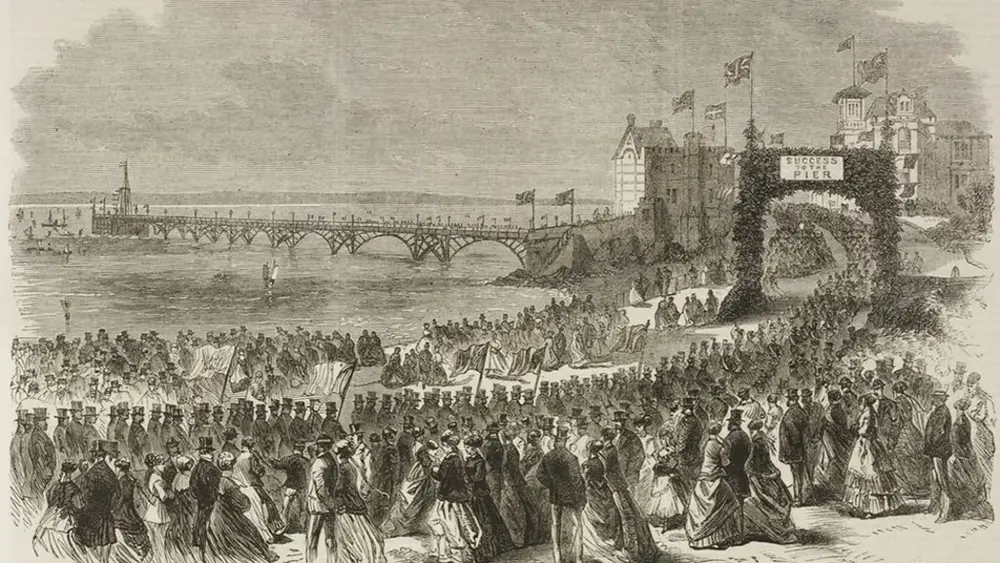
The opening of Clevedon Pier, 29 March 1869
Photo: Illustrated London News, 10 April 1869 via BBC News
The official opening of Clevedon pier was held on Easter Monday, 29 March 1869. Throughout the morning, large numbers had congregated at Clevedon railway station. The 10.15 train from Bristol alone had brought five hundred passengers!! Lady Margaret Ann Elton, the wife of Sir Arthur Elton of Clevedon Court, recalled:
There was a general holiday and floral arches had sprouted up all over the town. Altogether, two thousand people came by the Bristol and Exeter line, along with hundred of carts poured in from the country.
Finally assembled, a great procession left the terminus, consisting of twelve policemen, fifty-four members of the Clevedon Artillery and Band, ninety-four Nailsea Engineers and their Band, the directors of the Clevedon and Weston Pier Companies, twenty-eight members of the Committee of Demonstration, inhabitants and visitors, the Bristol Artillery Band, ninety Odd Fellows, the Axbridge Drum and Fife Boys, and five hundred school children.
Echoing the profound wishes of this great concourse, a huge triumphal arch astride the Marine Parade, carried the inscription, 'SUCCESS TO THE PIER'.
At 1.30pm the five hundred children burst into the singing of Psalm 148, and there was a short service of dedication, in which the local clergy also hinted that the opening of the pier should not be allowed to interfere with the observance of the Sabbath. There was then a cannon volley fired by the First Somerset Artillery, the massed bands played the National Anthem, and Clevedon pier was open for the good of the townspeople and the benefits which commerce would bring.
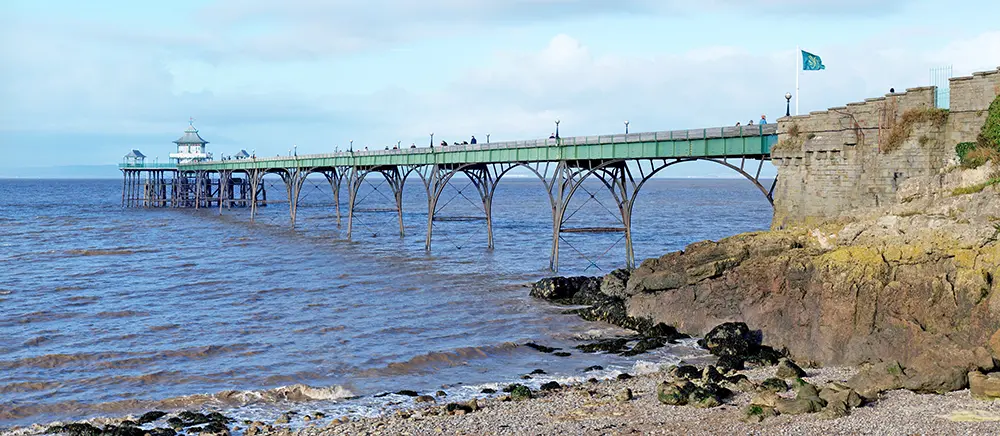
Clevedon Pier in 2009
Photo: Wikimedia
Sources and Resources
Derek Driscoll's original pages
Contemporary Biographies
Contemporary Biographies
Gala opening of the Clevedon Pier 29th March, 1869
Gala opening of the Clevedon Pier 29th March, 1869
Historical Records of 66th (South Midland) Field Brigade R.A. (T.A.)
Historical Records of 66th (South Midland) Field Brigade R.A. (T.A.)
London Gazette References 1900-1913
London Gazette References 1900-1913
Other Sources
1st Gloucester RGA Volunteers Nominal Roll
Battery Diary - Clevedon Conservation Volunteers
Clevedon Military History Trail Circular - Discover Clevedon
Clevedon Military History Trail Circular (PDF) - Discover Clevedon
Clevedon Pier - Wikipedia
Clevedon Pier: A note in its Centenary year - Bristol Industrial Archaeological Society (BIAS)
Clevedon Pier: The 150-year-old 'soul' of a seaside town - BBC
Clevedon's Victorian Gun Battery - Walking the Battlefields
Gun Battery - Clevedon Conservation Volunteers
Medals from the Rob Campbell Collection - Noonans of Mayfair
The History of Clevedon Pier - Clevedon Pier
